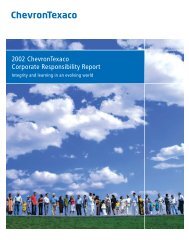Energizing California - Chevron
Energizing California - Chevron
Energizing California - Chevron
You also want an ePaper? Increase the reach of your titles
YUMPU automatically turns print PDFs into web optimized ePapers that Google loves.
<strong>Energizing</strong> <strong>California</strong><br />
Milken Institute<br />
<strong>Chevron</strong> and Cawelo are collaboratively exploring the possibility of using constructed wetlands to improve the<br />
water-treatment system for use in agriculture. This is an instance in which the location of a homegrown anchor<br />
firm is proving to have wider collateral benefits to its region. Through its understanding of local conditions,<br />
<strong>Chevron</strong> was able to form a highly targeted response to the San Joaquin Valley’s ongoing water shortage.<br />
<strong>Chevron</strong>’s conservation efforts in <strong>California</strong> have extended beyond water-use issues. The presence of twentyseven<br />
oil rigs off the <strong>California</strong> coast has long been the center of heated debate regarding environmental<br />
protection and threats to marine life. But ironically, the submerged portions of these rigs may have the potential<br />
to become habitats for a variety of creatures. In 2001, legislation outlining an artificial reef plan was approved by<br />
<strong>California</strong>’s state legislature, but was vetoed by the governor, who cited the need for further study. 34<br />
As part of <strong>Chevron</strong>’s “Rigs to Reef” initiative, the <strong>California</strong> Artificial Reef Enhancement (CARE) Program was set<br />
up as a nonprofit organization dedicated to researching the role artificial reefs might play in the underwater<br />
ecosystem. Its board of directors is made up of members from <strong>Chevron</strong>, the United Anglers Association, Diving<br />
Unlimited International, and the Professional Association of Diving Instructors. 35<br />
Before this program existed, <strong>California</strong> law required oil companies to remove offshore oil rigs after expending<br />
the oil wells entirely. However, the removal process involves heavy machinery that needs to be imported from<br />
other continents. It also requires intensive use of diesel fuels that cause tremendous amounts of air pollution.<br />
Through a potential Rigs to Reefs program, <strong>Chevron</strong> would remove only the top half of an oil rig, preserving the<br />
submerged portions as habitats for marine life. While keeping these structures in place would obviously result in<br />
cost savings for <strong>Chevron</strong> and other oil companies, researchers have noted the abundance of sea life drawn to the<br />
rigs and questioned whether using these structures as man-made habitats might result in a win-win situation.<br />
This partial, rather than full, removal process can lead to savings in energy use and a reduction of pollution from<br />
diesel use. 36<br />
Building Social Capital<br />
The presence of a major anchor firm, particularly a leading Fortune 500 company, brings with it multiple benefits<br />
that percolate throughout the surrounding metropolitan region. Large corporations typically choose to base<br />
their operations in locations that offer strong knowledge assets and fundamental infrastructure that can be<br />
leveraged to create opportunities for growth. Cities compete fiercely to attract corporate headquarters for the<br />
obvious reasons—job creation and a larger tax base—but they also enjoy a range of subsidiary benefits. Some<br />
of these secondary advantages, such as the enhanced economic activity generated by a self-sustaining industry<br />
cluster, are macro effects, while others, such as community outreach programs, may be smaller in scale but<br />
specifically targeted to address social issues that can enhance the region’s quality of life.<br />
Anchor firms facilitate an upward spiral of entrepreneurship and assets, as related, self-sustaining industry<br />
clusters take root and mature. 37 This phenomenon can be seen throughout the nation, from the impact of the<br />
SAS Institute in North Carolina’s Research Triangle to the effect of Micron Technology on the currently booming<br />
34<br />
Dan Rothbach, “Rigs to Reefs: Refocusing the Debate in <strong>California</strong>,” Duke Environmental Law & Policy Forum 17, 283 (http://www.law.duke.<br />
edu/shell/cite.pl?17+Duke+Envtl.+L.+&+Pol’y+F.+283).<br />
35<br />
<strong>California</strong> State Lands Commission, http://www.slc.ca.gov/Division_Pages/MRM/Rigs_to_Reef/Whitepaper.html.<br />
36<br />
“Report on Rigs to Reefs Conference,” event held in Huntington Beach, <strong>California</strong>, in March 2007; report available for download at http://<br />
www.coastkeeper.org/news/events/2007-03_rigs-to-reefs.asp.<br />
37<br />
Perry Wong, Benjamin Yeo, and Ross DeVol, Pittsburgh Technology Strategy (Milken Institute, 2006).<br />
30

















